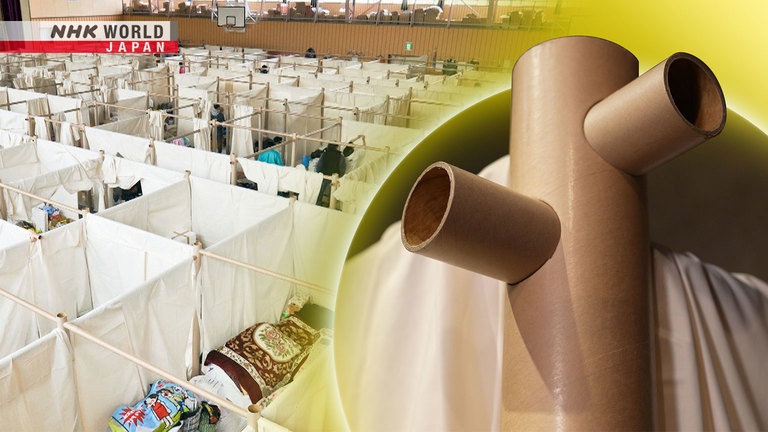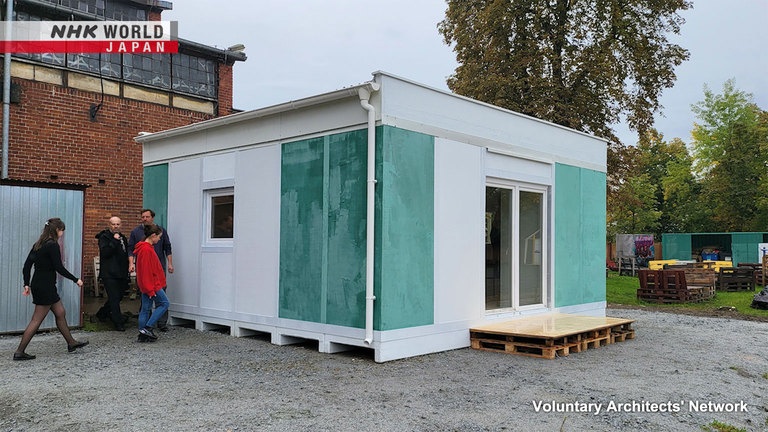Ban Shigeru: Designing Places of Refuge
[SPECIAL EDITION]
This series includes selected stories from BIZ STREAM's signature "On-Site" reports. In March 2022, the award-winning architect Ban Shigeru helped create special shelters in Poland for Ukrainian refugees. In September, he led a team of students in designing a prefabricated house that can be quickly made from materials available in Poland and Ukraine. This week's episode features an in-depth interview with Ban Shigeru to learn more about his mission to create places or refuge for displaced Ukrainians.
*Subtitles and transcripts are available for video segments when viewed on our website.
Ban Shigeru: Designing Places of Refuge


Transcript
Since Russia' s invasion of Ukraine began in February of 2022,
millions of Ukrainians have fled to neighboring European countries.
Just 2 weeks after the conflict began,
Ban Shigeru went to provide assistance at an emergency evacuation center located in Poland.
Teams of local volunteers quickly joined his cause and helped assemble special paper partition systems.
They can be put-together easily by almost anyone.
Each unit is 2 square meters in size.
Adding or removing dividing curtains allows for creating private rooms
or for opening them up to make larger gathering spaces.
"Thank you."
"Millions of Ukrainian refugees have to sleep in gymnasiums or in other large shared spaces."
"At the bare minimum, I feel that each person deserves to have some degree of privacy."
Ban first thought of using paper-based partitions back in 1995.
The Great Hanshin-Awaji Earthquake that struck in Western Japan's Hyogo Prefecture killed nearly 6,500 people...
and forced over 300,000 to evacuate their homes.
"I was shocked when I first saw the evacuation sites
and immediately wanted to help make a difference."
Because of their wide range of uses, paper tubes are manufactured in countries all over the world.
In addition to being easily procurable,
Ban felt that the light and easy-to-work-with tubes would be an ideal material during times of trouble
when quick installation was needed.
However, convincing others about the merits of using paper tubing wasn't easy.
In 2011, Ban once again found himself visiting evacuation centers following the Great East Japan Earthquake.
When he tried to introduce his paper partitions,
officials declined saying the material would be vulnerable to fire and water.
"Everyone said, 'There's no precedent for using something like that, so don't never allow it.'"
"But I refused to give up!"
Ban continued to visit evacuation centers with his paper-tube partitions.
"They're quite sturdy!"
Little by little, local governments began using the partitions,
and before he knew it, he had installed them in 50 different locations.
"Earthquakes aren't what kills people."
"Injuries or deaths usually occur when buildings or other man-made structures collapse."
"As architects, I think it's our responsibility to help those who have lost their homes to disaster."
His passion for helping evacuees has now rubbed off on people throughout Europe
who want to help support Ukrainian refugees.
Just 3 days after being contacted by Ban's team,
a Belgian paper company responded by donating over 10,000 paper tubes from its Poland-based factory.
"We were happy that we don't have to think how to support.
The solution is already in our hand."
Fellow architect Hubert Trammer over-saw the on-site assembly for the project.
Together with a crew of over 60 volunteers,
they worked to transform several evacuation shelters in Eastern Poland.
"When this information came from Shigeru Ban,
many people were encouraged."
By the time Ban reached the site to check on their progress,
the team had already completed over 300 units and the first facility was ready to receive refugees.
"I like it. It is great."
"Can you ask him how he feel about this?"
"Normal."
"Normal is important, right?"
Word of the partitions spread and soon other volunteer groups were installing them in facilities in France, Germany, and Slovakia.
"For temporary locations, we need easy to dismantle solutions,
as well as know what to do with the materials after use."
In September of 2022, Ban unveiled a prototype of a new kind of temporary housing he came up with for use in Ukraine.
The walls are made primarily of polystyrene foam.
Much like paper tubes, this material can easily be procured in most countries around the world.
The house's simple design allows it to be assembled without the help of professional builders.
"I want to prepare an affordable housing,
without depending on contractor."
Ban's former student, Dr. Jezy Latka and a group of about 40 student volunteers helped to build the prototype.
The wall panels are made from a thick layer of polystyrene foam
that is laminated with fiberglass reinforced plastic resin.
All materials used were sourced locally.
Each panel weighs less than 20kg.
Using just basic tools and bonding adhesive, the house only took about two weeks to complete.
"We all know that the aim is to build something important
and hope to develop it further."
"This is something unexchangeable to any money."
The day before unveiling the house, Ban visited a town in western Ukraine.
He hopes that his temporary housing will play a key role
in helping the country to be able to quickly recover and rebuild.
"Not only can this type of housing provide shelter, it can also create jobs."
"After the war, they will need to find work for many of the returning people."
"Since it can be built by almost anyone, it could also offer an instant source of employment."
One issue facing his current design, is that the wall panels aren't strong enough to be approved for housing in Ukraine.
In response, Ban sought the help of a world-class fiber glass manufacturer located in Japan.
The company specializes in producing components for racing cars
using ultra-light materials such as fiberglass and carbon fiber.
"Each one of these sheets is comprised of 4 layers of glass fibers oriented in four different directions."
By layering the sheets together, the design leaves no gaps in any direction and ensures uniform strength.
With the new panel design complete, Ban and his team plan on building another prototype for strength testing.
The manufacturer thinks this project may be the beginning of a new line of products.
"Now that we have an example of what we are capable of, it can serve as a foundation."
"This experience has given us the boost we need to enter into the housing industry."
Ban hopes to continue taking on various challenges,
and says that these experiences have helped to mold him into the architect he is today.
"As with any job, I think you never stop learning or improving - it's an ongoing process."
"For me, going to disaster stricken areas and working with local people
to build something together is part of how I learn and improve."
"So when I go out and work on these projects,
I am not doing something special, I am simply growing as an architect."